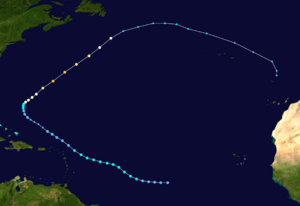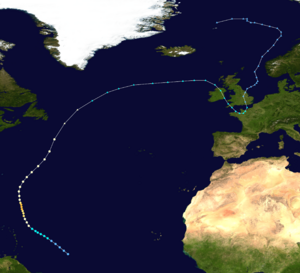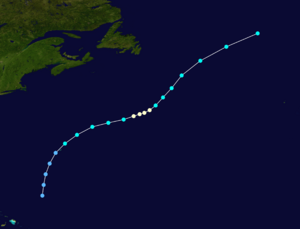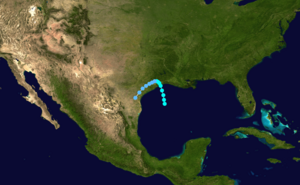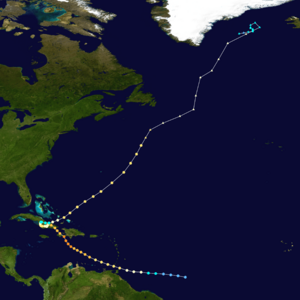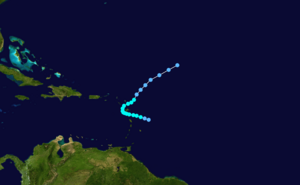1963 Atlantic hurricane season facts for kids
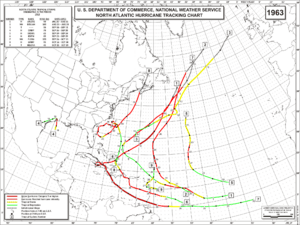 |
|
| Season summary map | |
| First storm formed | July 31, 1963 |
|---|---|
| Last storm dissipated | October 29, 1963 |
| Strongest storm | Flora – 940 mbar (hPa) (27.77 inHg), 145 mph (230 km/h) (1-minute sustained) |
| Total depressions | 9 |
| Total storms | 9 |
| Hurricanes | 7 |
| Major hurricanes (Cat. 3+) | 2 |
| Total fatalities | 7,225 |
| Total damage | $830.1 million (1963 USD) |
| Atlantic hurricane seasons 1961, 1962, 1963, 1964, 1965 |
|
The 1963 Atlantic hurricane season was a period when tropical storms and hurricanes formed in the Atlantic Ocean. It officially started on June 1, 1963, and ended on November 30, 1963. During this time, nine storms grew strong enough to be named.
The most well-known storm of the season was Hurricane Flora. It was one of the deadliest hurricanes ever recorded. Flora caused over 7,000 people to lose their lives, especially in Haiti and Cuba.
Contents
- Major Storms of 1963
- Hurricane Arlene: A Bermuda Visitor
- Hurricane Beulah: A Powerful Start
- Tropical Storm Three: A Small Storm's Journey
- Hurricane Cindy: Texas Rainfall
- Hurricane Debra: Heading North
- Hurricane Edith: Impact on the Caribbean
- Hurricane Flora: The Deadliest Storm
- Hurricane Ginny: A Snowy Surprise
- Tropical Storm Helena: A Changing Path
- Storm Names of 1963
- More About Hurricanes
- Images for kids
Major Storms of 1963
Hurricane Arlene: A Bermuda Visitor
A group of clouds in the central Atlantic Ocean started to spin and became a tropical storm on July 31. As it moved west, it grew stronger and became a hurricane on August 2. Arlene quickly became a Category 2 hurricane with winds of 100 mph (160 km/h).
Hurricane Arlene reached Bermuda on August 9. It kept its strong winds for a while before getting weaker. By August 11, it was no longer a tropical storm. Luckily, no one was harmed by Hurricane Arlene.
Hurricane Beulah: A Powerful Start
Before Hurricane Beulah got its name, it started as a tropical wave moving across the Atlantic. On August 20, it became organized enough to be called a tropical depression. The very next day, it grew stronger and became a tropical storm.
Beulah then moved towards the northwest, becoming a hurricane on August 22. By August 24, it had become a very large and powerful hurricane. It continued to move north, showing its strength early in its life.
Tropical Storm Three: A Small Storm's Journey
North of Puerto Rico, a weak storm began to move northeast. It was named a tropical depression on September 10. The next day, it gained enough power to be called a tropical storm.
This small storm reached its strongest winds of 60 mph (100 km/h) on September 12. After that, it did not get any stronger.
Hurricane Cindy: Texas Rainfall
Over the Gulf of Mexico, Cindy formed into a tropical storm on September 16. Just one day later, Cindy became a hurricane. It did not get any stronger before it made landfall near High Island, Texas.
Hurricane Cindy brought a lot of rain to southeast Texas as it moved across the state. It weakened on September 20. Cindy caused about $12.5 million in damage (in 1963 money) and sadly, three people lost their lives because of it.
Hurricane Debra: Heading North
On September 19, a tropical wave in the Atlantic Ocean turned into a tropical depression. Two days later, on September 21, it became a tropical storm. Debra did not hit any islands as it moved north.
Later on September 21, Debra grew even stronger and became a hurricane. It continued its path without directly affecting land.
Hurricane Edith: Impact on the Caribbean
On September 23, a tropical depression formed east of the Lesser Antilles. This storm was part of the Intertropical Convergence Zone, which is an area where winds from the Northern and Southern Hemispheres meet. It moved west and became a hurricane on September 24.
Edith passed through the Windward Islands on September 25 as a hurricane with 95 mph (140 km/h) winds. Strong winds high up in the atmosphere kept it from getting much stronger. It reached the Dominican Republic on September 27. The island's mountains caused the hurricane to weaken and disappear by September 29. Hurricane Edith caused $47 million in damage and tragically, ten people died in Martinique. About 50 people were injured across the Caribbean.
Hurricane Flora: The Deadliest Storm
Hurricane Flora was the most dangerous and deadly hurricane of the 1963 season. It caused over 7,000 people to lose their lives and led to hundreds of millions of dollars in damage. Flora is remembered as one of the most destructive hurricanes in history.
Hurricane Ginny: A Snowy Surprise
Hurricane Ginny was a very unusual storm. It is one of the few hurricanes in recent times to make landfall near New England. What made Ginny even stranger was that it brought 18 inches (50 cm) of snow to parts of Maine!
Sadly, Hurricane Ginny caused 7 people to lose their lives and created about $300,000 in damage (in 1963 money).
Tropical Storm Helena: A Changing Path
Tropical Storm Helena formed on October 25. It reached its strongest winds of 50 mph (80 km/h) before it reached the Lesser Antilles. Helena's strength changed a lot over the next three days, getting weaker and stronger.
Even though it was not a very powerful storm, Helena caused 5 people to lose their lives and created $500,000 in damage.
Storm Names of 1963
The names listed below were used for tropical storms and hurricanes that formed in the Atlantic Ocean in 1963. Names that were not used are shown in gray.
|
|
|
Retired Name
The name Flora was so devastating that it was never used again for another hurricane. This is done to remember the serious impact of such storms.
More About Hurricanes
Images for kids
-
Rainfall totals in the Greater Antilles from Hurricane Flora


